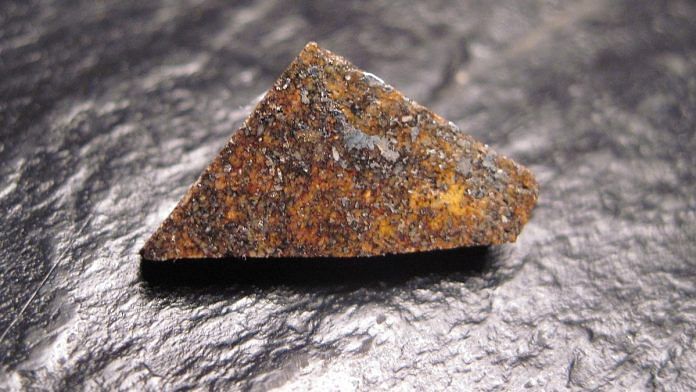New Delhi: A new species of sabre-toothed, carnivorous mammal has been discovered in southern California by scientists from the University of Arizona and the San Diego Natural History Museum.
The fossil — which was housed in the San Diego Natural History Museum’s paleontology collection — offers a window into what the Earth was like during the Eocene period, more than 40 million years ago.
The specimen includes a lower jaw and well-preserved teeth, shedding light on the behaviour and evolution of some of the first mammals that had an exclusively meat-based diet.
The ability to sustain on an all-meat diet isn’t uncommon today, but 42 million years ago, mammals were only just figuring out how to survive on meat alone.
A big leap in evolution was specialised teeth for slicing flesh — which were found on this fossil.
This early meat-eating predator is part of a now extinct, mysterious group of animals called Machaeroides. However, they are not closely related to today’s carnivores.
The predator was about the size of a bobcat, but with a downturned bony chin to protect its long, upper sabre teeth, it would have been a powerful and relatively new kind of hunter. Read more.
Also Read: Endurance, ‘Titanic of polar exploration vessels’, is found 107 yrs after Antarctic shipwreck
Sinkholes opening up Arctic seafloor
In a first, scientists have documented how the thawing of permafrost, submerged underwater at the edge of the Arctic Ocean, is causing the seafloor to collapse.
The study shows that while deep sinkholes have formed in some areas, ice-filled hills called ‘pingos’ have risen from the seafloor. Unstable land negatively impacts important Arctic infrastructure such as roads, train tracks, buildings and airports. This infrastructure is expensive to repair, and the impact and costs are expected to continue to increase.
While the degradation of terrestrial Arctic permafrost is attributed in part to increase in mean annual temperature from human-driven climate change, the changes the research team documented on the seafloor are associated with submarine permafrost derived from much older, slower climatic shifts related to our emergence from the last ice age. Similar changes appear to have been happening along the seaward edge of the former permafrost for thousands of years.
This is the first time that researchers have been able to deploy technology to see changes happening offshore in the Arctic. The data shows that the phenomenon is not a result of an ocean warming trend, and is rather driven by heat carried in slowly moving groundwater systems. Read more.
Blob-like structures that influence continental changes
Meanwhile, researchers have studied two massive blob-like structures, roughly on opposite sides of the planet, that greatly influence continental changes in topography, gravity, surface volcanism and plate motion.
Earth is composed of several layers — a thin outer crust, a thick viscous mantle, a fluid outer core and a solid inner core.
Within the mantle are two blobs — formally referred to as Large Low-Shear-Velocity Provinces (LLSVPs) — each the size of a continent and a hundred times taller than Mount Everest. One is under the African continent, while the other is under the Pacific Ocean.
Using instruments that measure seismic waves, scientists know that these two blobs have complicated shapes and structures, but despite their prominent features, little is known about why the blobs exist or what led to their odd shapes.
A team from Arizona State University set out to learn more about these two blobs using geodynamic modeling and analyses of published seismic studies.
Through their research, they were able to determine the maximum heights that the blobs reach and how the volume and density of the blobs, as well as the surrounding viscosity in the mantle, might control their height.
They found that the blob under the African continent is about 1,000 km higher than the blob under the Pacific Ocean. The blob under the African continent is also most likely less dense — and therefore less stable — than the one under the Pacific Ocean.
These findings may fundamentally change the way scientists think about the deep mantle processes and how they can affect the surface of the Earth. Read more.
Also Read: From body to brains and personality, here’s how humans will look like after 10,000 years
Fallen meteorite found using drone and AI
Researchers have recovered a freshly fallen meteorite after pinpointing its exact location using a drone to collect footage of the landscape, which was then scanned using Artificial Intelligence.
The new method has the potential to greatly increase the number of recovered meteorites, particularly those observed as they fall through the atmosphere.
A camera-fitted drone flies over and collects images of the fall zone, which are transferred to a computer where an algorithm scans each image for meteorites and features that resemble them.
Traditionally, meteorite searches involve a group of people walking over a large predicted impact area. The new method requires only about one tenth the amount of labour and time — and has a much higher likely success rate. Read more.
New species of tree frog discovered in Vietnam
An international team of researchers has identified a new species of the tree frog genus ‘Theloderma’ in northeastern Vietnam.
Theloderma is a poorly understood group of tree frogs, because they are very hard to track.
The genus has at least 26 known species distributed throughout southeast Asia, southern China and northeastern India.
Vietnam has more Theloderma species than any other country — with a total of 16 species recorded to date.
The discovery of an additional species suggests that the current species richness of the genus remains underestimated.
The new species was discovered in June 2020. It has been named Theloderma khoii and was recorded at elevations between 1,320 and 1,750 m above sea level. Read more.
Also Read: India gets 1st preprint server back — ‘IndiaRxiv’ aims to be one-stop shop for domestic research



